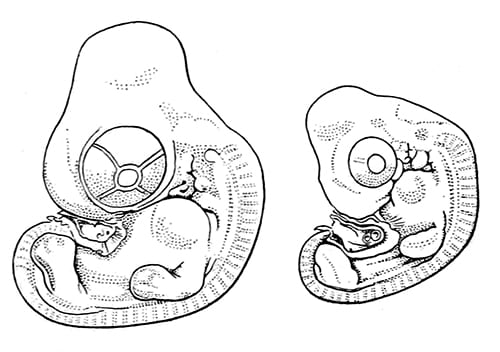What do embryonic eagles look they look like as they develop and grow inside their eggs? Dr. Peter Sharpe from the Institute for Wildlife Studies developed a table of bald eagle embryonic development based on work done by Hamburger and Hamilton (1951). While not all bald eagle eggs hatch in 35 days, the stages of development look something like this…
 Development of a chick, drawing from Frank Lillie photos. Artist William Sillin
Development of a chick, drawing from Frank Lillie photos. Artist William Sillin
What happens between the third and the 11th day? When we last touched on the topic, our embryonic eagle had inner and outer layers, a developing circulatory system, a brand new heart, and an anterior-to-posterior template in place. It looked more like a tadpole than an eagle, but the stage was set for it to begin developing limbs, a head, and eyes.
 Chicken embryos 23 to 27% of the way through development. The left illustration is roughly equivalent to the embryo in the youngest egg at Decorah North as of March 2, 2021.
Chicken embryos 23 to 27% of the way through development. The left illustration is roughly equivalent to the embryo in the youngest egg at Decorah North as of March 2, 2021.
Between 4 and eleven days…
- Three extra-embryonic membranes seal around the developing embryo. The embryo is surrounded by an amniotic membrane, which cushions it and keeps it properly hydrated. The amniotic membrane is surrounded by an allantoic membrane, or allantois, which stores nitrogenous wastes produced by the embryo. The allantoic membrane is surrounded by a chorionic membrane, or chorion, which facilitates the exchange of oxygen and carbon dioxide between the embryo and the egg’s external environment. These three membranes form a sort of womb that supports the embryo as it grows and develops.
- Wing, tail, and leg buds form.
- Eyes begin to form and develop pigment.
- The neck thins, clearly separating the embryo’s head from its body.
- Leg buds grow larger than wing buds and limbs begin to form.
- Elbow and knee joints are distinct by roughly 8 days and digital grooves – the precursors of toes and wing structures – are distinct by roughly nine days.
- The embryo’s beak and tongue begin to form.
- The egg tooth and two scleral papillae form between the 11th and 12th day.
At eleven days, the tiny embryonic eagle is about 27% of the way to hatch and still doesn’t look especially birdlike. It has a head, the beginnings of an eye, stiff differentiated limbs that are just beginning to bend, the beginning of a beak, rudimentary digestive organs, and a defined sex. The stage is set for further organization. Next up? An egg tooth, true eyes, and feather germs.
Illustrations were taken from Popular Science Monthly/Volume 71/September 1907/The Problem of Age, Growth and Death III: Link. Thanks to artist William Sillin for allowing us to use his lovely illustrations: http://www.willsillin.com/ (check it out – his illustrations are very cool!). Also take a look at this cool plate by Keibel and these lovely photos of chicken embryos: http://www.microscopy-uk.org.uk/mag/artnov04macro/mlchicken.html.
Things that helped me learn about this subject:
 The Raptor Resource Project
The Raptor Resource Project The Raptor Resource Project
The Raptor Resource Project